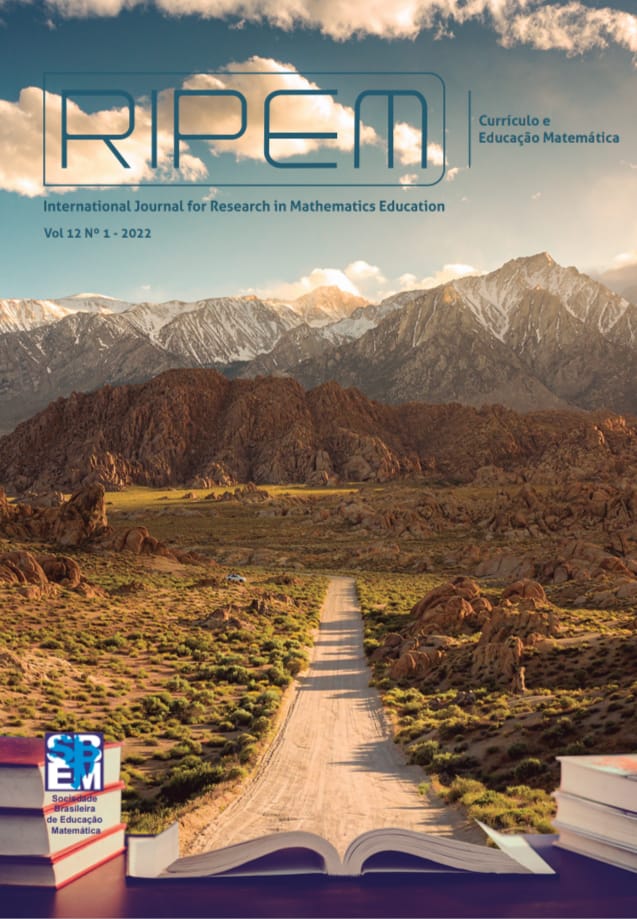Higher Education Mathematics curriculum: an experiment with the inverted classroom methodology
DOI:
https://doi.org/10.37001/ripem.v12i1.2887Keywords:
Mathematics Education, Syllabus, University Education, Active Methodologies, Differential EquationsAbstract
Active methodologies, such as Hybrid Teaching and Inverted Classroom, can help in the teaching and learning of students, as they are alternatives that can be used to attract students' interest in the study of mathematical content, as they contemplate technological and social interactions. In this context, this study reports on the application of the Inverted Classroom model in Higher Education in a class of Differential Equations. The aim of this study is to present a didactic activity involving the content of differential equations solved through separable variables, based on an application of the Inverted Classroom in Higher Education. The methodology used was qualitative research, which sought to carry out a didactic planning using the Inverted Classroom as a teaching methodology and its application. Works with this scope aim to present, to teachers, instruments that can be used in classes, and that will serve as a basis for the construction of other plans, using active methodologies, more specifically the Inverted Classroom, supported by technological tools . Based on the analysis of the results of this insertion of the Inverted Classroom, it was possible to observe that the students initially do not come to the Classroom prepared, as they had not yet organized themselves to watch the Pre-class videos and thus would not be able to respond in a manner transparent diagnostic assessment. It also showed that at the time of the dynamics held in the Class, there was time for interaction between students and the teacher, since the concepts had already been explained at the time of the Pre-class and highlighted the importance of planning in case students do not understand the explanations presented in the video classes.
Downloads
References
Almeida, M. E. B. & Valente, J. A. (2011). Tecnologias e CurrÃculo: trajetórias convergentes ou divergentes? São Paulo: Paulus.
Alves, L. R. G.; Minho, M. R. S. & Diniz, M. V. C. (2014). Gamificação: diálogos com a educação. In: FADEL, L. M. et al. (Org.). Gamificação na educação. São Paulo: Pimenta cultural.
Bacich, L., Moran, J. (2018). Metodologias ativas para uma Educação inovadora: uma abordagem teórico-prática. Porto Alegre: Penso.
Bacich, L.; Neto, A. T. & Trevisani, F. M, (2015). Ensino HÃbrido: Personalização e Tecnologia na Educação. São Paulo: Penso.
Bender, W. N. (2014). Aprendizagem Baseada em Projetos: Educação Diferenciada para o Século XXI. Tradução de Fernando de Siqueira Rodrigues. Porto Alegre, ed. Penso.
Bergmann, J. & Sams, A. (2016). Sala de Aula Invertida: uma metodologia ativa de aprendizagem. Grupo Editorial Nacional – Editora LTC.
Horn, M. B. & Staker, H. (2015). Blended: usando a inovação disruptiva para aprimorar a educação. Porto Alegre: Penso.
Hung, H. T. (2015). Flipping the classroom for English language learners to foster active learning. Computer Assisted Language Learning, v. 28, n. 1, p. 81-96,
Lovato, F.L., Michelotti, A. Silva, C. B. & Loretto, E.L.S. (2018). Metodologias Ativas de Aprendizagem: uma Breve Revisão. Acta Scientiae, Canoas, v.20, n.2, p.154-171.
O'Flaherty, J. & Phillips, C. (2015). The use of flipped classrooms in higher education: a scoping review. Internet and Higher Education, v. 25, p. 85-95.
Scheunemann, C.M.B.; Almeida, C.M.M. & Lopes, P. T.C. (2020). Sala de Aula Invertida no Ensino e Aprendizagem de Anatomia Humana: Análise do Desempenho e Percepções de Acadêmicos da Ãrea da Saúde. Acta Scientiae (Canoas), v. 22, p.151-174.
Severo, E. A.; Guimarães, J. C. F. de & Serafin, V. F. (2019). Formação docente: metodologias ativas de aprendizagem para ensino superior. Revista Educação: Teoria e Prática, 2019.
Thomas, G. B. (2012). Cálculo. Volume 1, 12° Edição, Pearson Education do Brasil, São Paulo.
Trevelin, A. T. C.; Pereira, M. A. A. & Oliveira, J. D. N. (2013). A utilização da “Sala de Aula Invertida†em cursos superiores de tecnologia: comparação entre o modelo tradicional e o modelo invertido “flipped classroom†adaptado aos estilos de aprendizagem. Revista de Estilos de Aprendizagem, Madrid, v. 11, n.12, p. 137-150.
Published
How to Cite
Issue
Section

This work is licensed under a Creative Commons Attribution-NonCommercial-NoDerivatives 4.0 International License.








